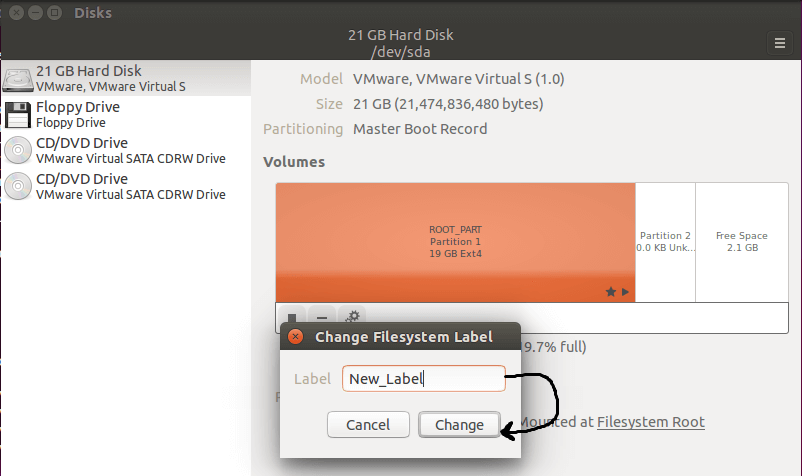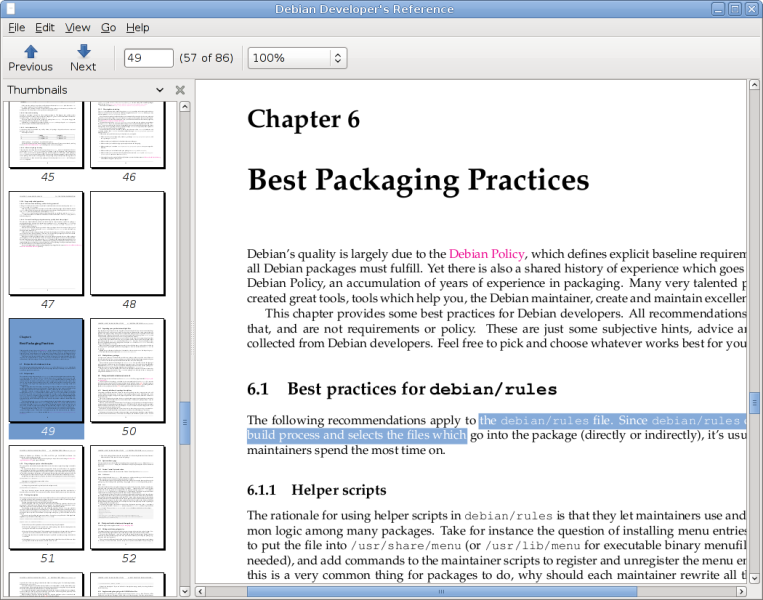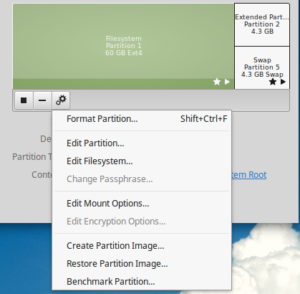44 linux list disk labels
Detect and mount USB devices in Linux from console 24.1.2019 · Device names depend on which (physical) slot you connect the device, and if there are other devices already attached or not, so the filename to refer to them may change over time.. Labels are more stable than filenames, but they may change or have the same name as other label.. The best way to mount a device is using the UUID, as you can be sure it won’t change … Labels - Linux Documentation Project Labels are not mandatory for a linux volume. Each can be a maximum of 16 characters long. There are three tools to make volume labels: mke2fs, tune2fs and e2label. 6.1.1. Simple Invocation. e2label /dev/hdb1 pubsw. tune2fs -L pubsw /dev/hdb1. Either of thse two commands will label the first partition of the second drive "pubsw".
How to Mount and Unmount Storage Devices from the Linux Terminal May 28, 2019 · We will tell mount to mount the file system on the floppy disk in the floppy drive that is connected to /dev/sdb to the /mnt mount point. Insert the floppy disk into the floppy drive and connect the floppy drive to a USB port on the computer. Issue the following command: sudo mount /dev/sdb /mnt. File System Labels

Linux list disk labels
Best Linux Distros Of 2022 - TechRadar May 08, 2022 · Here’s our complete list of the best weird and wonderful niche Linux distros. What is a Linux distro? A Linux distro, or distribution to use its full name, is an operating system built around ... Mounting Partitions Using UUID and LABEL on Linux LABEL on the other hand is a short name that you can put it when you format a partition to identify the disk. Many people can use the same LABEL. So, the uniqueness of LABEL depends on how creative you are at naming your partitions. In this article, I will show you how to mount partitions using UUID and LABEL using the /etc/fstab file on Linux ... Linux fdisk command and examples - Computer Hope Nov 30, 2020 · fdisk -l. List the partition information of the computer you're logged into. Below is an example of what this output may look like: Disk /dev/sda: 250.0 GB, 250059350016 bytes 255 heads, 63 sectors/track, 30401 cylinders Units = cylinders of 16065 * 512 = 8225280 bytes Device Boot Start End Blocks Id System /dev/sda1 * 1 191 1534176 83 Linux /dev/sda2 192 2231 16386300 83 Linux /dev/sda3 2232 ...
Linux list disk labels. How to get drive label in Linux using C from userspace ... I need to get a label for specific device using c/c++ (and no d-bus) in linux. The problem is that i can't just open device and read it's information (for extN it is very easy to get label from device) because reading from /dev/xxx requires root privileges. How to label disk in Linux with blkid - Linux Tutorials ... Use the syntax below to add a label to any disk partition of your choosing. $ sudo e2label /dev/sda5 "MY_BACKUP" Another way to add a label is with the tune2fs command. The following syntax would be used to add a label to our /dev/sda5 partition. $ sudo tune2fs -L "MY_BACKUP" /dev/sda5 LINUX - fdisk : how to label a partition? - Learn in 30 ... View all Disk Partitions in Linux: The following basic command list all existing disk partition on your system. The '-l' argument stand for (listing all partitions) is used with fdisk command to view all available partitions on Linux. The partitions are displayed by their device's names. For example: /dev/sda, /dev/sdb or /dev/sdc. How to get disk partition UUID in Linux - Donuts UUID is typically just a symlink to the actual device name in /dev directory, and you can get the UUID of a partition by browsing /dev/disk/by-uuid / directory. There are also some command-line programs that you can use to get partition UUID in Linux . Steps to get partition UUID in Linux: Launch terminal. List partition UUID from /dev.
A beginner’s guide to disks and disk partitions in Linux 8.11.2014 · I am trying to make a partition to install Linux Mint 20.3 on an older Windows 10. I got through the installation and get to the partitions, all is fine. Then i look at the output. Linux installer correctly labels Windows7, windows10 and backup partitions and shows a new linux partition, BUT the output is a Single partition of the entire hard ... Chapter 9. Advanced Topics - VirtualBox On a Linux host, to create an image that represents an entire physical hard disk which will not contain any actual data, as this will all be stored on the physical disk, use the following command: $ VBoxManage internalcommands createrawvmdk -filename \ path-to-file .vmdk -rawdisk /dev/sda How To - Linux List Disk Partitions Command - nixCraft lsblk Command to list block device on Linux To list all block devices, run the lsblk command: $ sudo lsblk $ sudo lsblk /dev/DEVICE $ sudo lsblk /dev/sda $ sudo lsblk -l # use the grep command /egerp command to filter out info # $ sudo lsblk -d | grep disk How To List Disk Partitions In Linux - OSTechNix There are many ways to view disk partitions in Linux. First, we will start with lsblk command line utlity. 1. List disk partitions in Linux using lsblk command The lsblk utility is used to display information about a specified block device as well as all available block devices, along with their partitioning schemes in Linux.
How to find Linux filesystem by Label or UUID using findfs ... Linux includes by default a bunch of useful filesystem tools that can be used to locate filesystems or partitions with specified tags or display the whole list of block devices along with their labels, universally unique identifiers (UUIDs) or default mount points. Linux Change Disk Label Name on EXT2 / EXT3 / EXT4 File ... How to change disk name on the ext4 file system on a Ubuntu Linux using command line? You need to use the e2label command to set a text label to your disk drive partitions and then refer to them in the /etc/fstab file. The e2label command must be run as root user. Normal users can not modify partition label for security reasons. [donotprint] IT Infrastructure | IBM Use your preferred Linux® solution, including Red Hat®, SUSE, or Ubuntu, on secure IBM servers. Explore Linux servers. Resources. A guide to modernization . See how modernization and a culture of change work together. Explore the ebook A hybrid cloud strategy. Uncover findings from IT leaders on ... 6 Different Ways to List Disks in Linux Command Line Listing Hard Drives in Linux 1. df 2. fdisk 3. lsblk 4. cfdisk 5. parted 6. sfdisk There are several ways to list all the hard drives present in a system through Linux command lines. Keep in mind a hard drive could be physically connected, virtually connected or even emulated (for example: when you use storage devices such as EMC, Sun or IBM).
4 Ways to Show all Drives (Mounted and Unmounted) on Linux The "lsblk" command can be used to display the system drives in Linux in the manner shown below: $ lsblk. The output produced by this command is shown in the following image: Method # 4: Using the "parted" Command: The "parted" command can be used to display the disk partitions in Linux in the manner shown below: $ sudo parted -l
Guide to Virtual Disk Images | Baeldung on Linux As the name suggests, a virtual disk image (VDI) is a replica of a portion of the actual hard disk.Apart from being a sector-by-sector copy of an HDD, it also consists of the complete contents and data structure of a physical hard disk. The virtual disk images are regular files. Virtual machines will treat an image file as a container.

Linux 101 : Why we label a disk or a partition? - e2label, mkfs.ext4, labels, UUIDs - - IT hands-on
How To Find Hard Disk Drive Details In Linux - OSTechNix Check Hard Disk Drive Details In Linux Using Lsblk Lsblk is a command line utility to display all available or the specified block devices in Unix-like operating systems. It reads the "sysfs" filesystem and "udev db" to gather information. The lsblk command is part of the "util-linux" package, which comes pre-installed in most Linux distributions.
How to name/label a partition or volume on Linux - Linux ... Both above commands will set partition label of /dev/sda1 block device to Boot. Please note that the maximum. label length is 16 bytes that is 16 characters. Let's check the partition label. name again: # e2label /dev/sda1 Boot. To list label name for all partitions or volumes you may try to use blkid command:
How to label disk in Linux with blkid - Linux Tutorials 14.12.2021 · The purpose of this tutorial is to show how to label a hard disk in Linux. Labeling hard drives under a Linux system gives a user a better way to organize all of the block system’s devices on their system. In this tutorial, you will see how to use the e2label and tune2fs commands to lavel a hard drive partition in Linux. You will also see how to use blkid to read …
Linux blkid Command to Find Block Devices Details In this tutorial we learn about blkid command in Linux and how to use it to find UUIDs. blkid usage Simply running blkid without any argument will list all the available devices with their Universally Unique Identifier (UUID), the TYPE of the file-system and the LABEL if it's set.
Linux fdisk command and examples - Computer Hope 30.11.2020 · fdisk -l. List the partition information of the computer you're logged into. Below is an example of what this output may look like: Disk /dev/sda: 250.0 GB, 250059350016 bytes 255 heads, 63 sectors/track, 30401 cylinders Units = cylinders of 16065 * 512 = 8225280 bytes Device Boot Start End Blocks Id System /dev/sda1 * 1 191 1534176 83 Linux /dev/sda2 192 2231 …
how to list all hard disks in linux from ... - lost saloon There are several different commands that you can use in a Linux environment to list disks that have been mounted on the system. df The df command is primarily intended to report file system disk space usage. It is still a good utility to print out the disks that are available to the system, although it prints filesystems rather than disks per se.
Three applications for making disc labels - Linux.com gLabels allows you to print both CD booklets and labels for the discs themselves. The inclusion of paper templates and the ability to fairly quickly make your own, guided by a well designed wizard, is a wonderful feature. Kover's interface lets you make a jewel case quickly, though for more involved designs you might like to use gLabels.
Find UUID of Storage Devices in Linux - Linux Hint You can find the UUID of all the disk partitions on your Linux system with the blkid command. The blkid command is available by default on most modern Linux distributions. To find the UUIDs of your disk partitions, run the following command: $ sudo blkid As you can see, the filesystems that has UUID are displayed.
disk - List all partition labels - Ask Ubuntu Simply labels? $ ls /dev/disk/by-label/ Download MuruHome Ubuntu Windows8 arch Or better: $ tree /dev/disk/by-label/ # or use ls -l /dev/disk/by-label/ ├── Download -> ../../sda6 ├── MuruHome -> ../../sdc2 ├── Ubuntu -> ../../sdc1 ├── Windows8 -> ../../sda2 └── arch -> ../../sda1
7 easy methods to check disk type (HDD or SSD) in Linux ... Here I have another setup with SSD disks: Method 3: Using disk model number. We can get the model number of the disk using lsblk command: # lsblk -d -e 7 -o NAME,ROTA,DISC-MAX,MODEL NAME ROTA DISC-MAX MODEL nvme0n1 0 2T SAMSUNG MZQLB960HAJR-00007 nvme1n1 0 2T SAMSUNG MZQLB960HAJR-00007. If you are using any kind of RAID such as hardware or software raid then it is possible you won't get the ...
Getting disk label in Linux in C/C++ - Stack Overflow find -L /dev/disk/by-label -inum $ (stat -c %i /dev/sda1) -print That is, stat () the device file you care about and remember its inode number. Iterate over all of the files in /dev/disk/by-label, and stat () each of them. When the inode number matches, then the name of the matched file is the label of that disk.
Disk partitioning - Wikipedia Disk partitioning or disk slicing is the creation of one or more regions on secondary storage, so that each region can be managed separately. These regions are called partitions. It is typically the first step of preparing a newly installed disk, before any file system is created. The disk stores the information about the partitions' locations and sizes in an area known as the partition table ...
How to List Disks in Linux Command Line - LinOxide In this tutorial, we learn how to list disks in Linux using the command line. 1. lsblk lsblk (list block devices) is used to list information of all available block devices, such as hard disk, and flash drives. Just typing the command lsblk will list all block devices in form of a tree format. This is the handy and simple way to list disks. $ lsblk












Post a Comment for "44 linux list disk labels"